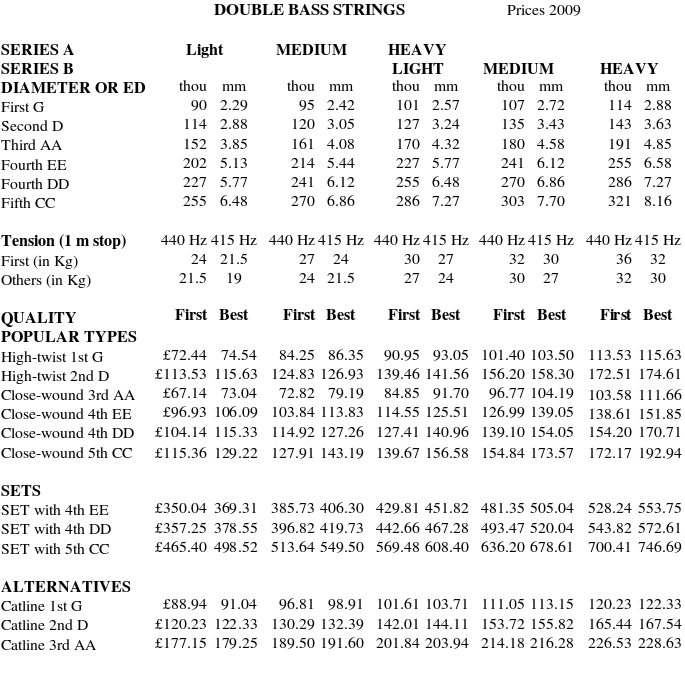
Northern Renaissance Instruments
6 Needham Avenue, Chorlton-cum-Hardy, Manchester M21 8AA, U.K.
Phone & Fax. +44 (0) 161 881 8134; proprietor: Dr. Ephraim Segerman [USA]
e-mail: post@nrinst.co.uk ; on internet: http://www.nrinst.co.uk
VIOLONE & DOUBLE BASS STRINGS
The sets included here cover the range of tensions that our customers have been asking for. Series A sets have lower tension, appropriate for bass viol players in small early ensembles, while series B sets, at higher tensions, are for double-bass players in baroque orchestras. Historical tension (or diameter) information is scarce. A mid-18th century Italian source gave information implying that the 3rd GG of a 3-string Contrabasso was at about 25 Kg. A mid-19th century French source implies that the 1st and 2nd double bass strings were at about 50 Kg each, and a c.1900 English source implies that the first three strings were at about 40 Kg. Modern double-bass tensions are about 30 Kg. More information is in Historical Stringing if Violones and Double Basses.
Some modern players have been making a distinction between the Violone as a delicate viol-like somewhat-smaller instrument and the Double Bass as a more robust orchestral instrument. Historically, the terms were completely equivalent, covering all of the instruments with 3, 4, 5 or 6 strings, that could play lower than cello C. The Italian term 'Contrabasso' was equivalent to these in the 18th century. Our lower-tension Violone sets are appropriate for chamber music, but for orchestral playing, we recommend our Heavy or Extra-Heavy sets.
Before the end of the 17th century, the Violone in D was the Violone Contrabasso, an enormous instrument with about a 50 inch vibrating string length having all-gut stringing. In the 18th century, the usual 40-inch Violone could use a wound 6th string to emulate a Contrabasso (and thus would be called one), but it usually kept the G tuning whether it used wound strings or not. Smaller instruments such as the original-size 32-inch string length bass viols emulated common Violones (in G) with a wound 6th string. The 50-inch one, with the lowest string often tuned to CC, was preferred for consistent 16-foot pitch in the big opera orchestras. In the G tuning used by the usual-sized and smaller instruments, points (motives) that went below the bass clef were played up an octave at 8 ft pitch, and points that didn't go this low were played at either 8-foot or down an octave at 16-foot pitch. Having this choice was important for the player's musical expression, and accounts for the popularity of this tuning. This preference for octave ambiguity also accounts for the tuning of the theorbo.
Modern insistence on keeping a consistent 16-ft pitch option has induced the invention of a modern 'period' orchestra Double-Bass tuning, with the EE string tuned down to DD, and occasionally a fifth string to CC. Our Double Bass table includes a row for each of these choices. For 3-stringed instruments, if the 1st is tuned to A, go two columns lighter (left) on that row, and if the 3rd string is tuned to GG, go two columns heavier (to the right) on that row. Historically, only the 3rd string was ever wound with metal, and not often so. Stainer's Dictionary (1899) specified that it was all gut. For 5-string instruments with tuning A,F#,D,AA,FF, go one column lighter on the 4th string for the FF, one column heavier on the 1st string for the F#, and two columns lighter on the 1st string for the A. Historically, only the FF string was wound in Haydn's orchestra. If any desired columns are not displayed here, we would be glad to supply that information.
The double bass 4th strings we make have a larger proportion of metal in the weight than 3rd strings. Since metal is cheaper than gut for the same weight, a 3rd string (on or off the table on the right) which weighs the same as a 4th string (on or off the table on the left) costs more. Some 4th strings from early in the 20th century that we have seen have very thin windings on a thicker gut core. This makes sense since a more 'gutsy' sound provides more of the fundamental in the string sound, the pitch not provided by the cellos in octave doubling. We can make such a string (as well as an all-gut catline 4th), but the greater gut content makes the string more expensive.
We do not keep stocks of wound strings or thick catlines for violones and double basses, and only make them to order. For a wound string, it takes about three weeks for the core to stretch before we can safely wind on it, so we request anticipation of needs in good time.
The windings on wound strings are of silver-plated copper on 'first' quality strings, or solid silver on 'best' strings. Strings in 'Best Quality' columns are unwound gut strings of First Quality that have been given the 'Best' treatment for greater durability and stability. The cores of all wound strings are given this treatment. There is a surcharge of £14.70 for smooth polished catlines. Polished catlines were historically used much less on large instruments such as these than on smaller instruments.


